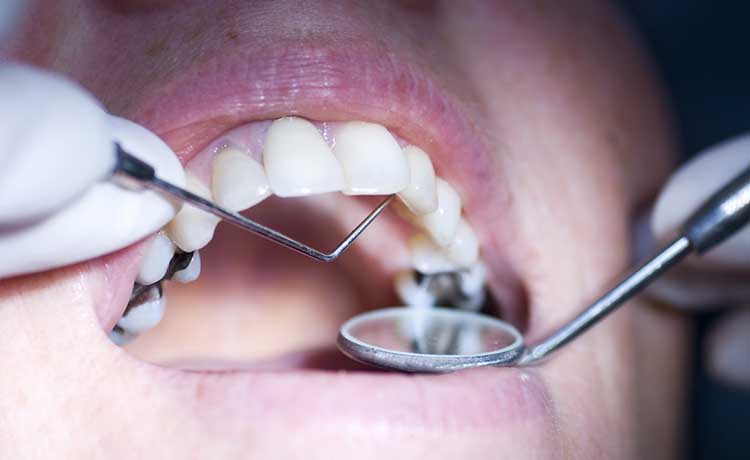June 11, 2019

Do you know that cavities are one of the nation’s leading health issues? But many times, when you have a cavity you aren’t aware of the initial signs. Usually, this is because the signs of a cavity can shadow other oral health ailments. When you have a cavity you might not experience pain in the beginning, but as time progresses symptoms will become more apparent. If you experience any of the below symptoms, you’ll need to visit a dental clinic.
The following are initial signs of a cavity:
Tooth Stains
Are there any stains on your teeth? Dark stains on your teeth that are black or brown can indicate a cavity. Before you consider teeth whitening, you’ll need to determine the cause of your tooth stains. This shouldn’t be confused with stains that temporarily appear after eating dark-coloured foods like chocolate or popsicles. These kinds of stains will disappear once you brush your teeth and rinse your mouth. However, if you spot a stain on your tooth that doesn’t fade after a reasonable amount of time has passed, it is likely that you have a cavity. Also, be on the lookout for holes in your teeth. If you notice a visible hole in your tooth it may be a consequence of tooth decay. In which case, you should visit your dental clinic in Winnipeg and have a professional evaluate your concern.
A Highly-Sensitive Tooth
Have you experienced increased sensitivity recently? This uncomfortable feeling may signify a cavity. Usually, sensitivity arises when consuming hot or cold foods and beverages. Also, consuming foods or beverages that are particularly sweet can trigger sensitivity. Sensitivity is caused when the cavity compromises the nerve within the tooth. Because of the close proximity between the cavity and the nerve, changes in temperature are more prominent. Don’t brush off mild sensitivity, make sure to visit a dental clinic near you to assess the problem. Minimal sensitivity can be a discrete indication of a cavity.
Chalky Spotting
Healthy teeth have a layer of enamel that is completely clear. If there is a chalky or opaque looking spot on your tooth, it means your tooth does not have enough minerals, specifically calcium.
Bad Breath
When food particles become stuck between your teeth, your breath might smell funky. But if you have noticed your breath has become foul and the smell doesn’t seem to disappear then you may have a cavity.
A Bad Taste
Not only can dental caries cause bad bread breath, but you may experience a bad taste in your mouth too. If you notice that the bad taste lingers after you’ve finished eating, drinking, or smoking, you may have a cavity. Be sure to bring this issue to your Winnipeg dentist’s attention.
Bloody Gums
Do you notice blood on your sink after you brush your teeth? Bloody gums can signal a cavity. Brushing can trigger the gums to bleed due to the damaged nerve which causes irritation. If the bleeding doesn’t subside, you most likely have a deep cavity.
Gum Issues
If you have large cavities along your gum line, food particles can become lodged and cause problems. In specific, there will be visible swelling of the gums which may not be painful.
Preventing Cavities
Now that you know which signs to look out for when it comes to detecting a cavity. You’ll need to know which simple tips you can use to prevent cavities and improve your oral health.
Brush twice daily and use the right technique
Brushing your teeth eliminates bacteria in your mouth. You should always brush your teeth twice daily, once in the morning and once at night. Brushing your teeth at night is especially important, as it can prevent bacteria from lingering on your teeth and enamel erosion. Use the proper brushing techniques below each time you pick up your toothbrush:
• Buy a soft-bristled toothbrush. You won’t want to irritate or damage your gums, so be sure to apply gentle pressure. Don’t be too aggressive, if you’re squashing the bristles, you’re brushing too hard.
• Place your toothbrush at a 45-degree angle against your gums. Carefully brush your toothbrush back and forth using short, tooth-wide strokes. To clean the inside surfaces of your front teeth, place the toothbrush on them and use a light stroking motion.
• Often times, we get so caught up brushing our teeth, we neglect our tongue. After you’re done brushing your teeth, brush your tongue to eliminate bacteria and freshen your breath.
Note, don’t forget to schedule a dental check-up every 6 months. This appointment can detect dental problems early on and prevent them from worsening.
 1440 Jack Blick Ave #104, Winnipeg, MB R3G 0L4, Canada
1440 Jack Blick Ave #104, Winnipeg, MB R3G 0L4, Canada 204-774-2521
204-774-2521


